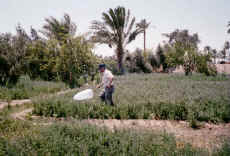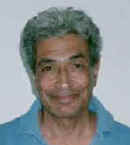![]()
Pollinator Paradise
Parma R & E Center
PSES
College of Agriculture
University of Idaho
Research slide shows
Bee management
Philosophy
Links
Contact us
![]()
 |
Alfalfa and Clover Pollinators in Egypt Report on a visit to Ismailia, Egypt, May-June
2001
|
| Dr. Kamel collects bees in an
alfalfa field on reclaimed land near Suez. Photo by K. Strickler, May 2001 (click on image to see an enlargement) Table of Contents: Background Children pose in an Egyptian clover field near Luxor Transporting the clover harvest to town, El Tal Elkebeer. Table of Contents Background Mud houses where Megachilid pollinators of clover and
alfalfa nest, El Tal Elkebeer. Students Hanan and Davina observing bees in mud
walls, El Tal Elkebeer. Table of Contents Background Close-up of mud wall with bee nests: old mud around
new. El Tal Elkebeer. Polystyrene nest boards for M. unifromis.
El Tal Elkebeer. Table of Contents Background
|
BackgroundEgyptian clover, Trifolium alexandrinium, is the traditional forage crop in Egypt. Planted since at least the time of the Pharaohs, it is grown as an annual crop in the winter and spring. After several cuttings for hay, a few fields are left an extra month to set seed, while the rest of the crop is plowed under to make way for summer crops. Egyptian clover is part of a mandated crop rotation in much of the Nile delta where cotton is grown for export. Alfalfa, Medicago sativa, is a relatively new crop in Egypt (except in the oases, where regional cultivars have been planted for many years). Alfalfa is grown as a perennial and provides high quality forage and green manure. Varieties are available and are being bred that are well-adapted to reclaimed agricultural lands, which do not have a mandated crop succession. Currently there are 200-300,000 acres of alfalfa planted in Egypt, and acreage is rising each year. However, most commercial alfalfa seed is purchased from foreign sources. Egyptian researchers would like to insure self-sufficiency and stable high yields in seed production for locally adapted, high quality alfalfa varieties for reclaimed lands. Dr. Soliman Kamel of Suez Canal University is working to develop management protocols for native solitary bee species that pollinate clover and alfalfa in Egypt. Female solitary bees such as some members of the genus Megachile pollinate most of the flowers that they visit. As in other parts of the world, honeybees are a poor pollinator of alfalfa because they take nectar without tripping the flower and exposing the stamens and stigma for pollination. Bees: one of Egypt's important natural resources.Egypt has a rich diversity of bees. An unpublished collaborative study in the 1960s and 70s, involving Dr. Frank Parker of the USDA Bee Biology and Systematics Laboratory, and researchers from Cairo University and the Egyptian Ministry of Agriculture, identified at least 36 species of bees that forage on alfalfa and clover, and numerous additional species on other important crops. Most notable was a community of Megachilid bees that make their nests in tunnels in the walls of mud houses. The tunnels are initiated by Megachile bees in the subgenus Chalicodoma: M. flavipes and M. nigripes (formerly C. mucorea). After the Chalicodoma emerge, their nests are reused by several species of Megachile in the subgenus Eutricharia. In the 1960s and 70s, M. submucida was studied as a potential pollinator of alfalfa. As the number of nests increase from year to year in a mud wall, parasite populations, including Coelioxys and Radoszkowskiarda also increase. This community of bees nesting in mud houses is particularly interesting because of the mutualistic relationship between humans and bees. The bees depend on people to create a dynamic nesting habitat consisting of constantly renewed mud walls and alfalfa and clover fields. In exchange, the bees provide a service to the farmers by pollinating flowers so seed can be harvested for the following year. After funding ended in the 1970s, research on solitary bee pollinators in Egypt languished for a quarter century. During that time, undoubtedly many populations of Megachile in mud houses were displaced or eliminated as modern brick and cement block buildings replaced traditional mud houses. Then, in 1998 Dr. Kamel discovered a population of Megachile (Chalicodoma and Eutricharia) in the mud walls of houses in El Tal Elkebeer, a city of 140,000 people 50 km west of Ismailia. In this population, Megachile uniformis, is the most abundant species of Eutricharia nesting in abandoned Chalicodoma tunnels. This bee species is in the same genus, and similar in size, to the alfalfa leafcutting bee M. rotundata, used in North America for alfalfa pollination.On my visit to Egypt in May and June, 2001, Dr. Kamel and I collected bees from alfalfa and clover fields in Suez, El Tal Elkebeer, Ismailia and Luxor to see what species were present now, and to compare the bees in alfalfa vs. clover fields. (see a partial list of bees collected) We found that M. aff. uniformis did, indeed forage from alfalfa in El Tal Elkebeer. We found at least two other species of Megachile (Eutricharia) also foraging on clover and alfalfa: M. aff. submucida and M. aff. coelioxoides. (Our thanks to Terry Griswold for tentative identifications of the bees). Other notable visitors in the fields were the same two Chalicodoma found in earlier studies, Megachile patellimana, at least 3 species of Ceratina (Pithitus), Amegilla sp., at least two species of Andrena, and Pseudapis (Nomia) sp. Most honey bees were collected in clover fields; few were observed foraging in alfalfa, especially if clover was blooming nearby. Collections at the mud walls of El Tal Elkebeer included the Chalicodoma, M. uniformis, a number of solitary wasp species, and several parasitic cuckoo bees: Coelioxys decipicus, C. aff. afra, and Radoszkowskiarda gymnopygia. On-going and future research.Dr. Kamel has demonstrated that M. uniformis will nest in polystyrene nest blocks similar to those used in North America for M rotundata. Polystyrene nest blocks have the advantage of being lightweight, easy to move, and not subject to theft if left in public places. (Wood bee nests, usually more attractive to Megachile than polystyrene, are likely to be confiscated for firewood). Bee cells can be easily removed from polystyrene nest blocks for winter storage and management of diseases and parasites. We determined that the bees should probably be left at room temperatures during the winter rather than cooling them for prolonged periods at 5C as is done in Northern latitudes. Winter temperatures average 15-18oC in Ismailia, and rarely dip below 7oC. M uniformis cannot tolerate storage at temperatures lower than 10oC for prolonged periods. However, warm fall and winter temperatures allow chalcid parasites to develop, and their populations easily increase to decimate stored bee populations. Dr. Kamel is researching ways to control parasite populations during winter storage of the bees. He hopes to develope management techniques for these bees so that they can be used for pollination of alfalfa for seed in Egypt. Dr. Kamel and Prof. Shoukry are to be commended for their efforts to conserve native bee pollinators, one of Egypt's natural resources. |
Suez Canal University was established in 1976. The special purpose of the University is to serve the development and improvement of the Suez canal and Sinai regions of Egypt. These are important geographic areas within the country that have significant resources and opportunities for growth and development. The University has 4 campuses distributed throughout the Suez: Canal-Ismailia region at Ismailia, Port Said, El Arish and Suez. There are about 2500 faculty and about 40,000 students.
Dr. Kamel teaches Apiculture and Pest Management in the Entomology Department of the Faculty of Agriculture at Suez Canal University in Ismailia. He can be reached at:
| Dr. Soliman Kamel Department of Entomology Faculty of Agriculture Suez Canal University Ismailia, Egypt |
 |
![]()
Top of page Pollinator Paradise
Parma R & E Center
PSES College of Agriculture
University of Idaho
Research slide shows
Bee management
Philosophy
Links
Contact us
![]()
June 17, 2002
Copyright © 2002 Karen Strickler. All rights reserved.